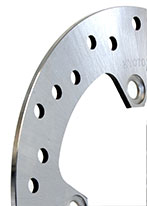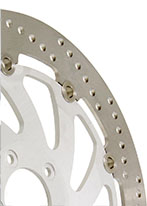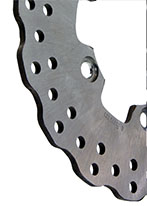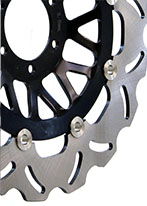The disc brake is a wheel brake which works by stopping the motorcycle wheel from rotating using friction. The friction is caused by pushing the brake pads against the brake discs hydraulically, using a set of calipers. The brake disc is connected to the wheel and/or the axle and this friction causes the wheel to slow down or stop by converting the motion (or kinetic energy) to heat. Disc brakes first appeared in 1962 but have evolved and become more sophisticated since then.




These are disc brakes with holes or slots drilled into them. This serves several purposes, the holes let the rainwater through them more easily so that the brake discs don't get so slippery when it's wet. They also cool more quickly helping the efficiency of the brakes by preventing overheating. Slots machined in the disc aid the removal of dust and oil residue and help to deglaze the brake discs so that they are less slippery.
These are discs which are loosely fitted and rest on small dowels which allow them to move slightly laterally. The advantage of this is that it prevents heat transfer from the brake to the wheel hub and gives the disc space to expand into when heated by friction, without causing tension which might lead to eventual warping. It also allows the disc to be centred better when used with a fixed caliper.
These discs are relatively new on the market and have holes in them and a 'wavy' outside edge. This provides a more efficient area of pad contact compared to standard round discs. They allow for more heat dissipation as well.
Due to both manufacturer's over-zealous lock tightening and reaction between metals in the fixing screws over time, a bit of controlled violence is often necessary to remove the old disc. Hit the bolts hard before trying to undo them and use good quality unworn tools for the job. Sometimes drastic measures are needed, perhaps a small chisel and a BIG hammer. Welding a large bolt to a destroyed bolt head is not unknown. Good luck, take your time and in the overused words of one major workshop manual publisher it should be easy:
'simply disassemble by removing all fasteners and use the opposite process to reassemble.'